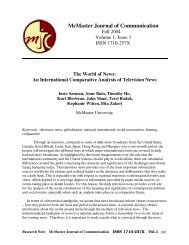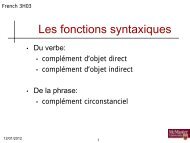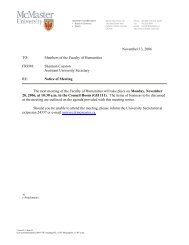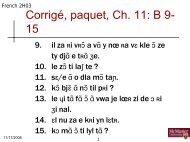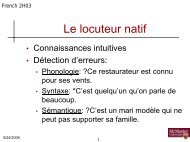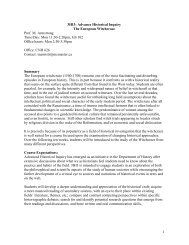The Syntax of Givenness Ivona Kucerová
The Syntax of Givenness Ivona Kucerová
The Syntax of Givenness Ivona Kucerová
You also want an ePaper? Increase the reach of your titles
YUMPU automatically turns print PDFs into web optimized ePapers that Google loves.
We will see in chapter 4, however, that the correlation with definite articles is not accidental.<br />
I will argue that the purpose <strong>of</strong> both reordering for givenness and definiteness marking<br />
is to maximize presupposition (Heim, 1991). While the two strategies are in principle different,<br />
their realization may sometimes be identical.<br />
I thus argue that the nature <strong>of</strong> the reordering found in (2-b) is indeed to mark that<br />
something has already been introduced in the discourse. An interesting fact to observe<br />
is that even though the SVO order has multiple interpretations, certain interpretations are<br />
excluded and they can be achieved only by reordering. This suggests that the purpose <strong>of</strong><br />
the reordering is to achieve an interpretation that would not be available otherwise. 5<br />
I will argue shortly that this ordering correlates with a requirement that given (old, presupposed)<br />
elements linearly precede elements that are new (asserted, non-presupposed) in<br />
the discourse. While in (2-a) this requirement can be satisfied within the SVO order, in<br />
case <strong>of</strong> the (2-b) examples, reordering is needed.<br />
<strong>The</strong> examples in (1-c) and (1-d), repeated below as (4-a) and (4-b), are rather different.<br />
While in the examples in (2-a) and (2-b) at least one participant has not been introduced in<br />
the discourse yet, the examples in (4-a) and (4-b) contain only previously introduced participants.<br />
In other words, the utterances in (2-a) and (2-b) correspond to an assertion that<br />
combines something already presupposed with something that has not been presupposed<br />
yet. In contrast, the utterance in (1-c)–(1-d) operates on an already asserted proposition.<br />
<strong>The</strong> meaning <strong>of</strong> the SOV order in (4-a) can be either verification <strong>of</strong> the true value <strong>of</strong> the<br />
proposition, or correction <strong>of</strong> a part <strong>of</strong> the proposition by excluding other alternatives. 6<br />
Similarly, the example in (4-b) corresponds to an utterance about already introduced participants<br />
and it comments on their relation (contrastive topic or topic).<br />
(4) a. SOV: <strong>The</strong> boy did find the lollipop. (He did not steal it.)<br />
b. OSV: As for the lollipop, the boy found it (but as for the chocolate, he got it<br />
from his mother).<br />
<strong>The</strong> study presented here concerns mainly the type <strong>of</strong> examples given in (2). Before I<br />
undertake a closer investigation <strong>of</strong> these cases I want to provide the reader with some further<br />
observations that will help to clarify why it is useful to treat the examples in (2) as separate<br />
from the examples in (4). We have already seen that the type <strong>of</strong> reordering witnessed in<br />
(2) may teach us something about the way presupposed and non-presupposed elements are<br />
marked in a language that does not have overt articles. Everything being equal, the English<br />
translations <strong>of</strong> the Czech examples in (2) differ only in the use <strong>of</strong> articles. <strong>The</strong>re are no<br />
other obvious changes in syntax, prosody or morphology. <strong>The</strong> English translations <strong>of</strong> the<br />
Czech examples in (4) are very different in this respect. Both have marked prosody (pitch<br />
5 We will see in this chapter and especially in section 1.2 that SVO is the basic word order in Czech. I will<br />
argue that a basic word order in general allows more flexibility in interpretation than a derived word order.<br />
6 In literature on information structure, this type <strong>of</strong> construction is <strong>of</strong>ten referred to as verum focus, i.e.,<br />
a construction where the speaker verifies or denies that an already presupposed proposition is true, or contrastive<br />
focus or correction, in case the speaker asserts an exclusion <strong>of</strong> an alternative that might have been<br />
introduced by the previous context.<br />
8







